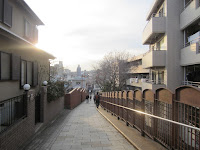2013-01-14
Shichi-fukujin @Yanaka:Jan. 13, 2013
Following yesterday, I made another Shichi-fukujin visit. It was in Yanaka area.
Information on Shichi-fukujin is on Jan. 12, 2013 post. Yanaka Shichi-fukujin is the oldest in Tokyo.
I started my walk from JR Tabata station. People attached red papers onto the statues guardian gods in Togakuji Temple. It is believed to be helpful to heal sick of the people. The temple enshrines FUkurokuji, one of shichi-fukujin.
I walked through Nishi-Nippori and Nippori area.
I visited Seiunji Temple (enshrines Ebisu), Shushoin Temple (enshrines Hotei), Tennoji Temple (enshrines Bishamon-ten) and Choanji Temple (enshrines Jurojin).
Pictures of Hotei were drawn on the walls of Shushoin Temple.
There is a slope called Fujimi-zaka near Nippori station. The slope is the last place in Tokyo where we can see whole scope of Mr. Fuji. The opportunity will be lost shortly as a new apartment is planned to be constructed.
I also walked in Yanaka cemetery, one of Tokyo’s largest cemeteries. I found Tokyo Sky Tree behind tomb stones.
I moved to Ueno area and visited Gokokuin Temple (snshrines Daikokuten) and Benten-do (enshrines Benzaiten).
Shichi-fukujin @ Yamanote (Shinjuku) area: Jan.12-13, 2013
Visiting Shichi-fukujin (Seven Gods of Fortune) is traditional Japanese custom at New Year season. Seven Gods include:
- Bishamon-ten (Vaiśravaṇa):Indian origin. Guard the world with three other gods.
- Daikoku-ten (Mahakala): Indian origin. Save poor.
- Benzai-ten (Saraswati): Indian origin. Goddess of water and agriculture
- Fukurokuju: Chinese origin. God of wisdom and longevity
- Jurōjin: Chinese origin. God of longevity
- Hotei (Budai): Chinese monk. Re hold a bag of fortune.
- Ebisu: Japanese old god. Calls prosperity
Some gods are placed at shrines while others are places at temples. Buddhism and Japanese traditional Shinto religion were fused (syncretized) in some aspects in the middle age. The syncretism composes one of features of Japanese culture.
There are groups of Shichi-fukujin in various areas in Tokyo. They include Yamanote Shichi-fukujin (Shinjuku area), Yamaka Shichi-fukujin, Nihonbashi Shichi-ifukujin, Asakusa SHichi-fukujin, Meguro (Yamanote) Shichi-fukujin (and more).
Today, I walked Yamanote SHichi-fukujin in Shinjuku Area.
The picture from above shows:
- Bishamon-ten @ Zenkokuji Templs in Kagurazaka
- Hotei @ Taisoji Temple in Shinjuku
- Ebisu @ Inarikiou Shrine in Shinjuku
- Fukurokuju @ Eifukuji Temple in Shinjuku
- Benzai-ten @ Itsukushima Shrine in Shinjuku
- Jurojin @ Hozenji Temple in Shinjuku
- Daikoku-ten @ Keiouji Temple in Ichigaya Yanagicho
2013-01-06
New Year’s visit to shrines: Jan.1-6, 2013
I spent my New Year days to visit several shrines. There were findings in every shrine.
I visited Meiji Shrine on Jan. 6. The shrine is one of most popular shrines in Japan and attracts millions of people every year.
There were thousands of visitors making long lines in front of the main building. “Haru no Umi” (The sea in spring), was played in the shrine and was making New Year’s atmosphere.
People were writing their hopes in the fortune tablets.
They put sacred paper fortunes they had bought on the wires. New Year’s fortune goods were sold.
Open air markets offered various foods. Blood donation was asked in front of the shrine.
I was in Sengen Shrine in Shizuoka city on January 1st.
I visited Yoyogi Hachiman Shrine on Jan. 2nd. The calligraphy works written by school children were displayed.
I also stopped at a mosque near the shrine.
Old fortune goods are collected at the shrine and are burnt. The custom is called “Otakiage”. Big shrines prepare special boxes for collection.
The situation at small shrines is different. There was a fire to burn such goods at a small shrine (Rokusho Shrine) near my house on Jan. 3rd.
Visitors looked happy in every shrine. It was probably because fortune people usually make new year’s visit to shrines.
Subscribe to:
Posts (Atom)



























